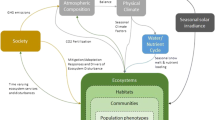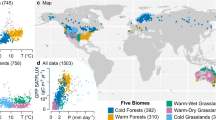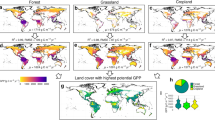Abstract
The National Climate Indicators System (NCIS) aims to provide a suite of systematically updated, easily interpretable, and policy relevant national metrics of key physical, ecological, and societal conditions. The NCIS will distill and communicate complex scientific information to a broad audience as part of sustained National Climate Assessments. The current NCIS has made significant strides in defining its scope, providing an initial suite of indicators, and outlining its future development goals. In line with the scope and aims of the NCIS, we present a set of terrestrial primary productivity indicators that are scientifically defensible, scalable, directly related to climate, nationally important, built on existing agency efforts, and linked to the conceptual framework of the NCIS. The Gross Primary Productivity (GPP) and Net Primary Productivity (NPP) indicators provide seasonal and annual metrics of the growth of all plant material across the contiguous U.S., Alaska, Hawaii, and Puerto Rico. The GPP and NPP products used to produce the indicators have become key carbon measurements of environmental health and ecosystem services, including food, fiber, and fuels supporting national economies, human sustainability, and quality of life. We demonstrate how the proposed GPP and NPP indicators are relevant across indicator system sector topics of Forests, Grassland/Rangelands/Pastures, Agriculture, Wildfire, and Seasonal Timing and Phenology, can be used in concert with existing proposed indicators, and will aid to filling current gaps in the NCIS.





Similar content being viewed by others
References
Allred BW, Smith WK, Twidwell D et al (2015) Sustainability. Ecosystem services lost to oil and gas in North America. Science 348:401–402
Ballantyne A, Smith W, Anderegg W et al (2017) Accelerating net terrestrial carbon uptake during the warming hiatus due to reduced respiration. Nat Clim Chang 7:148–152
Bastos A, Running SW, Gouveia C, Trigo RM (2013) The global NPP dependence on ENSO: La Niña and the extraordinary year of 2011. J Geophys Res Biogeosci 118:1247–1255
Belote RT, Aplet GH (2014) Land protection and timber harvesting along productivity and diversity gradients in the Northern Rocky Mountains. Ecosphere 5:1–19
Bright BC, Hicke JA, Meddens AJH (2013) Effects of bark beetle-caused tree mortality on biogeochemical and biogeophysical MODIS products. J Geophys Res Biogeosci 118:974–982
Buizer JL, Fleming P, Hays SL, et al. (2013) Report on preparing the nation for change: building a sustained national climate assessment process. National Climate Assessment and Development Advisory Committee
California Senate Bill SB 32, Pavley (2006) California global warming solutions act of 2006
Cleveland CC, Houlton BZ, Smith WK et al (2013) Patterns of new versus recycled primary production in the terrestrial biosphere. Proc Natl Acad Sci U S A 110:12733–12737
de Groot RS, Alkemade R, Braat L et al (2010) Challenges in integrating the concept of ecosystem services and values in landscape planning, management and decision making. Ecol Complex 7:260–272
Derner JD, Schuman GE (2007) Carbon sequestration and rangelands: a synthesis of land management and precipitation effects. J Soil Water Conserv 62:77–85
Field CB, Randerson JT, Malmström CM (1995) Global net primary production: combining ecology and remote sensing. Remote Sens Environ 51:74–88
Foley JA, Defries R, Asner GP et al (2005) Global consequences of land use. Science 309:570–574
Forest Service (2015) Collaborative forest landscape restoration program 5-year report, FY 2010–2014. Washington D.C. U.S. Department of Agriculture. FS-1047
Godschalk DR (2004) Land use planning challenges: coping with conflicts in visions of sustainable development and livable communities. J Am Plan Assoc 70:5–13
Goetz SJ, Fiske GJ, Bunn AG (2006) Using satellite time-series data sets to analyze fire disturbance and forest recovery across Canada. Remote Sens Environ 101(3):352–365
Hasenauer H, Petritsch R, Zhao M et al (2012) Reconciling satellite with ground data to estimate forest productivity at national scales. For Ecol Manag 276:196–208
Heller NE, Zavaleta ES (2009) Biodiversity management in the face of climate change: a review of 22 years of recommendations. Biol Conserv 142:14–32
Homer CG, Dewitz JA, Yang L et al (2015) Completion of the 2011 National Land Cover Database for the conterminous United States—representing a decade of land cover change information. Photogramm Eng Remote Sens 81:345–354
Houghton RA (2003) Revised estimates of the annual net flux of carbon to the atmosphere from changes in land use and land management 1850–2000. Tellus Ser B Chem Phys Meteorol 55:378–390
Janetos AC, Kenney MA (2015) Developing better indicators to track climate impacts. Front Ecol Environ 13:403–403
Jones MO, Kimball JS, Jones LA (2013) Satellite microwave detection of boreal forest recovery from the extreme 2004 wildfires in Alaska and Canada. Glob Chang Biol 19:3111–3122
Kang S, Lee D, Lee J, Running SW (2005) Topographic and climatic controls on soil environments and net primary production in a rugged temperate hardwood forest in Korea. Ecol Res 21:64–74
Kenney MA, Janetos AC, et al. (2014) National climate indicators system report. National Climate Assessment Development and Advisory Committee
Kenney MA, Janetos AC, Lough GC (2016) Building an integrated U.S. National Climate Indicators System. Clim Chang 135:85–96
Kim Y, Kimball JS, Zhang K, McDonald KC (2012-2016) Satellite detection of increasing northern hemisphere non-frozen seasons from 1979 to 2008: implications for regional vegetation growth. Remote Sens Environ 121:472–487
Kirby KR, Potvin C (2007) Variation in carbon storage among tree species: implications for the management of a small-scale carbon sink project. For Ecol Manag 246:208–221
Le Quéré C, Raupach MR, Canadell JG et al (2009) Trends in the sources and sinks of carbon dioxide. Nat Geosci 2:831–836
Mawdsley JR, O’Malley R, Ojima DS (2009) A review of climate-change adaptation strategies for wildlife management and biodiversity conservation. Conserv Biol 23:1080–1089
Milesi C, Elvidge CD, Nemani RR, Running SW (2003) Assessing the impact of urban land development on net primary productivity in the southeastern United States. Remote Sens Environ 86:401–410
Milesi C, Hashimoto H, Running SW, Nemani RR (2005-2007) Climate variability, vegetation productivity and people at risk. Glob Planet Chang 47:221–231
Milly PCD, Betancourt J, Falkenmark M et al (2008) Climate change. Stationarity is dead: whither water management? Science 319:573–574
North MP, Stephens SL, Collins BM et al (2015) Environmental science. Reform forest fire management. Science 349:1280–1281
Oregon Senate Bill 1547 (2016) 78th Oregon legislative assembly, Beyer. Relating to public utilities and declaring an emergency.
Oswalt SN, Smith WB, Miles PD, Pugh SA (2014) Forest resources of the United States, 2012: a technical document supporting the forest service 2010 update of the RPA assessment
Pan Y, Birdsey RA, Fang J et al (2011) A large and persistent carbon sink in the world’s forests. Science 333:988–993
Piao S, Friedlingstein P, Ciais P et al (2007) Growing season extension and its impact on terrestrial carbon cycle in the northern hemisphere over the past 2 decades. Glob Biogeochem Cycles 21:GB3018
Poulter B, Frank D, Ciais P et al (2014) Contribution of semi-arid ecosystems to interannual variability of the global carbon cycle. Nature 509:600–603
Reeves MC, Zhao M, Running SW (2006) Applying improved estimates of MODIS productivity to characterize grassland vegetation dynamics. Rangeland Ecol Manage 59:1–10
Reeves MC, Moreno AL, Bagne KE, Running SW (2014) Estimating climate change effects on net primary production of rangelands in the United States. Clim Chang 126:429–442
Running SW (2012) A measurable planetary boundary for the biosphere. Science 337(6101):1458–1459
Richardson AD, Black TA, Ciais P et al (2010) Influence of spring and autumn phenological transitions on forest ecosystem productivity. Philos Trans R Soc Lond Ser B Biol Sci 365:3227–3246
Running SW, Zhao M (2015) Daily GPP and Annual NPP (MOD17A2/A3) products NASA earth observing system MODIS land algorithm user’s guide
Running SW, Nemani RR, Heinsch FA et al (2004) A continuous satellite-derived measure of global terrestrial primary production. Bioscience 54:547–560
Sánchez ML, Pardo N, Pérez IA, García MA (2015) GPP and maximum light use efficiency estimates using different approaches over a rotating biodiesel crop. Agric For Meteorol 214–215:444–455
Smith WK, Cleveland CC, Reed SC et al (2012a) Bioenergy potential of the United States constrained by satellite observations of existing productivity. Environ Sci Technol 46:3536–3544
Smith WK, Zhao M, Running SW (2012b) Global bioenergy capacity as constrained by observed biospheric productivity rates. Bioscience 62:911–922
Smith WK, Cleveland CC, Reed SC, Running SW (2014) Agricultural conversion without external water and nutrient inputs reduces terrestrial vegetation productivity. Geophys Res Lett 41:449–455
Smith WK, Reed SC, Cleveland CC et al (2015) Large divergence of satellite and earth system model estimates of global terrestrial CO2 fertilization. Nat Clim Chang 6:306–310
Tallis H, Mooney H, Andelman S et al (2012) A global system for monitoring ecosystem service change. Bioscience 62:977–986
Vogler KC, Ager AA, Day MA et al (2015) Prioritization of forest restoration projects: tradeoffs between wildfire protection, ecological restoration and economic objectives. For Trees Livelihoods 6:4403–4420
Westerling AL, Hidalgo HG, Cayan DR, Swetnam TW (2006) Warming and earlier spring increase western U.S. forest wildfire activity. Science 313:940–943
Zhao M, Running SW (2010) Drought-induced reduction in global terrestrial net primary production from 2000 through 2009. Science 329:940–943
Zhao M, Heinsch FA, Nemani RR, Running SW (2005) Improvements of the MODIS terrestrial gross and net primary production global data set. Remote Sens Environ 95:164–176
Acknowledgements
Funding for this work was provided by the National Aeronautics and Space Administration; Research Announcement (NRA) NNH12ZDA001N Research Opportunities in Space and Earth Science (ROSES-2012) and NNX14AI69G Providing Continuity for the MODIS Land Gross Primary Production, Net Primary Production and Evapotranspiration Datasets. This work used eddy covariance data acquired and shared by the FLUXNET community, including these networks: AmeriFlux. The ERA-Interim reanalysis data are provided by ECMWF and processed by LSCE. The FLUXNET eddy covariance data processing and harmonization was carried out by the European Fluxes Database Cluster, AmeriFlux Management Project, and Fluxdata project of FLUXNET, with the support of CDIAC and ICOS Ecosystem Thematic Center, and the OzFlux, ChinaFlux and AsiaFlux offices.
Author information
Authors and Affiliations
Corresponding author
Additional information
This article is part of a Special Issue on National Indicators of Climate Changes, Impacts, and Vulnerability, edited by Anthony C. Janetos and Melissa A. Kenney.
Electronic supplementary material
ESM 1
(DOCX 766 kb)
Rights and permissions
About this article
Cite this article
Jones, M.O., Running, S.W., Kimball, J.S. et al. Terrestrial primary productivity indicators for inclusion in the National Climate Indicators System. Climatic Change 163, 1855–1868 (2020). https://doi.org/10.1007/s10584-018-2155-9
Received:
Accepted:
Published:
Issue Date:
DOI: https://doi.org/10.1007/s10584-018-2155-9




